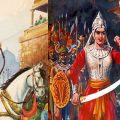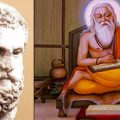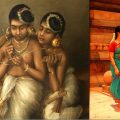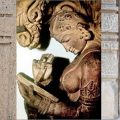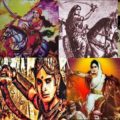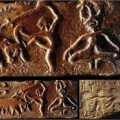What 4200 Year Old Sinauli Finds Say on Ancient Indian Women Warriors
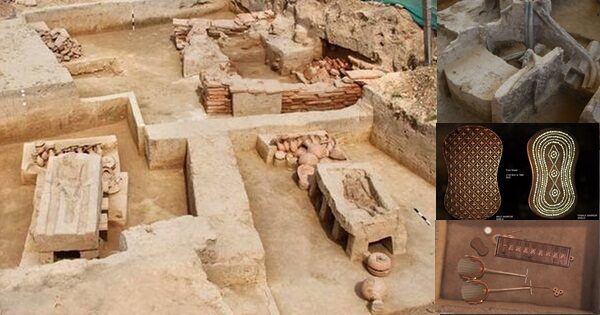
Sinauli is known for its chariot. Archaeologists of ASI (Archaeological Survey of India) under the leadership of Dr Sanjay Manjul excavated Sinauli in 2018 and he discovered 116 burials there. It is Asia’s largest burial site excavated as of now. It provided the first ever ancient chariot discovered in Bharatavarsha. This chariot is dated to 2100 BCE to 1900 BCE. It is a solid wheel chariot but contains triangular shaped radial reinforcements made of copper (a different kind of spokes), making it better than the spoked wheel fast chariots unearthed in other parts of the world, avoiding quick breakage of the wheels, while moving fast. The 3000 BCE and 2500 BCE solid wheel chariots unearthed from other cultures of the world like Mesopotamia pales in comparison with this advanced chariot unearthed from Sinauli. Sure they are 1000 and 500 years older, but to keep the Sinauli chariot in the same category as a solid wheel chariot is an injustice to this chariot.
The Sinauli chariot is amazing all by itself, but another important aspect that we need to discuss is about the female warriors of Sinauli. We have got the material evidence of our female warriors from Sinauli from where we got the shields of both men and women. The shields of male were decorated with copper decors. The shields of female warriors were decorated with white steatite! This is an important revelation from the Sinauli excavation. This is a matter of pride for our ancient Bharatiya civilization! These shields are obtained from the male and female coffins excavated from Sinauli. Male shield near male skeleton and female shield near female skeleton. Thus their association and usage by male and female warriors is very clear.
The shields were obtained along with many antenna swords. When a warrior is buried he or she is buried with the same weapons they used in battles. There are no separate ceremonial shields and swords. Hence we can conclude these shields and swords were actively used in battles by these men and women. Today some female embroidery on dresses and other decorative items have this pattern seen in this female shield unearthed from Sinauli!
No doubt our men dominated the wars, especially the Kurukshetra War which was an all-men war. But there were other wars where women warriors are mentioned as a dominant force such as the wars of Kartikeya who fought with the Asuras at Kurukshetra. In Devi Bhagavata and Skanda Purana too such armies with women warriors and women commanders are mentioned. Thus, both in literature and now in this corroborated material evidence at Sinauli we concluded that our women participated in wars. This is what the Sinauli archaeology record is saying. We cannot say contrary to what evidence says.
The ability to win a fight is not related to body muscles or body weight. It is not body mass or muscle mass that win a fight. Agility of the body, the sharpness of the eyes, the sharpness of the mind, the instinctive reactions, the dexterity of hand, quick thinking and intelligence – these are the factors that wins a fight. Women can excel as archers and swordsmen with light weight swords and lightweight shields. Sure, mace (gada) will be hard for them. Winning a battle is not primarily due to body muscles, body weight, body size etc, rather the skill and intelligence are more crucial in winning. What Sinauli proves is that it gives material evidence to our female warriors.
Except in special categories like mace fight and heavy weight weaponry male and female bodies are equally designed for warfare. Archery, lightweight swords, chariot riding all suitable for men and women equally. When we say equal, it is the potential and capability of the human body (both male and female ) to use weapons that we are talking about. Actual numbers of women participating in the wars may vary.
Certain attitudes like those expressed by Bhishma, that he won’t fight with a woman warrior, resulted in the Kurukshetra War to be an all-men war. In different versions of the Mahabharata, Sikhandi is varyingly described as a woman and as a neutral gender warrior. The Pandavas decided to include Shikhandi as a main commander in their army, despite the objections of the Kaurava army supreme commander Bhishma.
Subsequently in our recorded history, when the Abrahamic culture spread to different parts of the world, they considered women as mere property and reduced the value of women, forced them to disarm or didn’t train them in weapons. Women participation in warfare then declined compared to what was existing in the pre-Abrahamic polytheist societies. However not all men or all women possess warrior qualities. Hence many women choose to be non-warriors and excelled in dance and fine arts like many men chose to be non-combatants and excelled in trade, peasantry etc.
From our Itihasas, like Ramayana, we know that Kaikeyi participated in the war of her husband Dasaratha, protecting him in his chariot while the battle was raging. From the Harivamsha of Mahabharata, we know Satyabhama fought alongside Krishna during the Narakasura War. We know Subhadra rode the chariot while Arjuna fought with the Yadavas as they eloped from Dwaraka to Indraprasta. We know the warrior prowess of Draupadi and her ability to use lightweight swords, when Jayadratha tried to abduct her. Durga and thousands of named female warriors are mentioned in the Devi Bhagavata. Hordes of female warriors are mentioned in Skanda Purana, Devi Bhagavata and such texts. Onake Obavva, Rani Velu Nachiyar, Rani Abbakka, Bibi Dalair Kaur, Nayakuralu Nagamma, Jhansi Rani and many other female warriors are recorded in our medieval history fighting against the European colonial invasions of the Portuguese, British forces and the Mughal Islamic invasions.
Thus from Itihasaa we learn about Kaikeyi, Satyabhama, Panchali and Subhadra all trained as warriors. In the Puranas, Durga is hailed as our war goddess. From our recorded medieval history, we have plenty of warriors like Jhansi Rani and so on.
Here, at last, we are getting material evidence for the women warriors mentioned in our ancient texts, that is beyond any speculation. We see the evidence of the women warriors buried with their shields, swords and bows at Sanauli! When the material evidence of this sort emerges, there is no need for any speculation. Material evidence in archaeology is the end of all speculations, imaginations and conjecture works based on literary evidence alone. It changes all old perspectives and equations. Now did they win any battle or not? Archaeology cannot tell that, only a time machine can tell that.
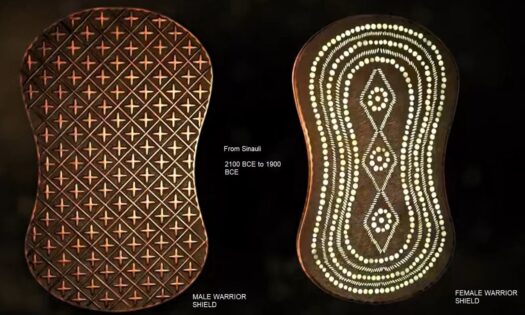
Artists’ impressions and representation of Sinauli shields of both men and women warriors. The shields of male warriors were decorated with copper decors. The shields of female warriors were decorated with white steatite! Image courtesy: ‘The Secret of Sinauli’ documentary by Neeraj Pande, aired in Discovery+ channel.
That is where narratives of goddess Durga, Kali, Dhumavati, Varahi and others help and also the 10000+ female warriors in the army of Kartikeya. These are deified female warriors. They represent our female ancestors who fought and won real battles. In Sanatana Dharma, our ancestors of great achievements are worshipped first and then they are later deified to become our gods and goddesses, like Krishna, Rukmini, Satyabhama, Rama, Sita and so is Durga and her many female generals.
Our society is always gender equal, in ways in which feminism of today can ever imagine. Hence going by such modern notions of Western Feminism is an injustice to our ancient culture. Our tradition doesn’t need feminism to strengthen our females as much as our tradition doesn’t need secularism to help live in harmony with diversity and differences. Already we know about female scholars in Rgveda. Female warriors are mentioned starting from our Itihasas.
Some analysts are dismissing Sinauli as unrelated to Vedic culture or Samskrti because the people are buried instead of cremated. It is sure cremation is popular in Sanatana Dharma, but burials are also present in our tradition. Burials are also mentioned in Rgveda as one of the ways in which the dead individuals are treated. The head-gear of some of the warriors contains horns. In the current depictions of our ancient people, the horned headgear is associated with the Daitya Danavas. It will be misleading to conclude that Sinauli is non Vedic based on these factors alone.
The Bharatas and their ancestors were an admixture of the Adityas, the Daityas and the Danavas. The ancestral king Yayati had two wives Devayani and Sharmistha. Devayani, is the daughter of Daitya Guru Shukracharya. She is the mother of Yadu and Turvasa, the eldest sons of Yayati. Sharmishta is the daughter of Daitya king Vrshaparvan. She is the mother of Anu, Drahyu and Puru, the younger sons of Yayati. The mother of all the Yadavas is Devayani and the mother of Puru, the founder of the Puru dynasty is Sharmistha, both Daitya women. The Bharatas descended from the Purus and the Kurus like the Pandavas and Kauravas descended from the Bharatas. Krishna, Balarama and other Vrshnis descended from the Yadavas.
The Danavas like Maya were allies of the Pandavas who gave them many weapons and chariots. The chariot of Arjuna came from Varuna, who is revered by the Bhargava sages like the Asura Guru Sukracharya and by the sages in the lineage of Vasistha and Agastya. Vasistha was the priest of Sri Rama. Vyasa was the descendant of Vasistha and the grandfather and guide of the Pandavas.
A place named after Maya viz. Mayastali (Meerut, 52 km away) is close to Sinauli. Vyaghra-prasta (Baghpat, 25 km away), Swarna-prasta (Sonipat, 29 km away), Paniprasta (35 km away), Varanavati (21 km away) mentioned in Mahabharata is all close to Sinauli. Hastinapura is 75 km to the east and Indraprasta is 55 km to the south of Sinauli. The place known as Parushurama Kshetra (now Alamgirpur) is 33 km away from Sinauli, where Parashurama taught weaponry to Bhishma. The region around Sinauli is dotted with places resembling chariot construction such as Rathora (Rathakara – chariot-maker, 6 km away) and Luhara (Lohakara – metal worker, 2 km away).
The name Sinauli is a derived form of Sina-sthali, akin to other place names in Kuru Rashtra ending with the suffix ‘sthali‘ (meaning – a place) like Bastali (Vyasa-sthali), Bamanauli (Brahmana-sthali). The place names in Kuru Rashtra, the region between Ganga in the east and Sarasvati in the west, divided by Yamuna into two parts, contains suffixes like Prasta, Sthali and Kshetra. The word ‘sina‘ means a ‘store’,’garment’ ‘fetter’, ‘bond’, ‘body’ etc, implying that it is one of the places associated with making chariots and weapons. Probably the people who lived in this Sinauli settlement were a warrior class of men and women supplying weapons to the army of the kings.
The presence of female warriors and the burial could indicate that these people participated in the wars like that of Kartikeya or Durga with high participation of women, rather than the Kurukshetra War where the presence of women is not well attested in the literature.
The Rgveda mentions many wars and the Puranas render it as the wars between the Devas and Asuras. But if we analyze the Rgveda closely, these wars are fought between the people who worship Indra (like the Purus and the Bharatas) and other people who don’t worship Indra (like the Anus and the Drahyus). The Puranas portrayed the people who do not worship Indra as the Asuras, categorizing them as Daityas and Danavas. The word used by Rgveda for the non-Indra worshipers is Anindra – those who are without Indra and Avrata – those who don’t have any devotion to Indra. The Sinauli settlement with their burial practices and horned head-gears can as well belong to the groups affiliated to the Datya-Danavas, such as the Maya Danava.
But this doesn’t make them non-Vedic, because Danavas like Maya do have a place in our Veda, Itihasa Puranas. Besides the Rgvedic hymn 15 in the 10th Mandala speaks about both burying the dead (anagni-dagdha) and cremating them (agni-dagdha). The hymn 18 of the 10th Mandala talks about a burial house (grha) often compared to a womb (yoni) where ghee (clarified butter) is kept in pots. This matches with the 116 burial houses unearthed at Sinauli. They contain many earthen pots which could have been used to fill ghee, butter and medicines as explained in the Rgvedic hymn 18. This hymn also mentions about taking the bow from the hand of the dead and placing them besides the dead to honour the dead warrior (धनुर् हस्ताद् आददानो मृतस्यास्मे क्षत्राय वर्चसे बलाय). Exactly as mentioned in the Rgveda the bow of the warrior is placed beside the dead-body of the warriors in Sinauli. Along with the bow, other weapons of the warrior like the shields and swords are kept. Their chariots too are kept in the burial house.
Usually a pair of chariots are seen in the Sinauli burial houses, which is close to the descriptions of the pair of Soma Carts mentioned in the Rgveda (Hymn 13 of the 10th Mandala). One of them represents mortality (Yamayana) and another immortality (Devayana). The pair, Yama and Yami are the overseers of death since Yama chose mortality instead of immortality and is the first mortal. The hymn compares the deceased with Yama and Yami and urges them to choose mortality instead of immortality for the sake of the devatas and for the sake of their offspring. The hymn talks about the five steps (pancha padani) to climb the mount (rupa) and to ascend the four-legged bed (chatushpada) as per the ritual injunctions. These four legged death beds, where the dead body is placed are found in the Sinauli burials and by the mount, the verse may be referring to the burial mounts.
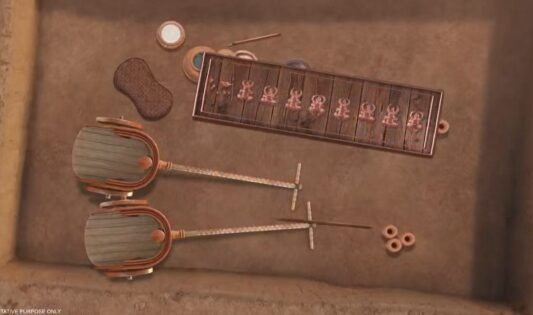
Artists’ impressions and representation of dual chariots of Sinauli. Image courtesy: ‘The Secret of Sinauli’ documentary by Neeraj Pande, aired in Discovery+ channel.
The Rgveda 10th Mandala hymn 15 also talks about ritual offerings of Soma and ghee to the forefathers inside the burial house. The ritual pots found inside the Sinauli burials indicate offerings made to these forefathers.
Thus the Sinauli burial sites resemble very closely with the descriptions of the funeral hymns in the 10th Mandala of Rgveda.
Whether these women warriors and their male warrior companions participated in the Kurukshetra War as one among the many small military units, depends on the chosen date of the Kurukshetra War. Sinauli excavations are dated to 2100 BCE to 1900 BCE.
One of the Kurukshetra War dates close to it is 1793 BCE proposed by Shri Ashok Bhatnagar. If we take this Kurukshetra War as the basis, then the Sinauli warriors were 100 to 300 years older to the Kurukshetra War, placing them as part of the late Rgvedic period, during the formative periods of the 1st, 5th, 8th, 9th or the 10th Mandalas, especially the 10th Mandala. Several battles are mentioned in these Mandalas similar to those in the older Mandalas.
Another date of Kurukshetra War 1952 BCE is from Shri Mohan Gupta. If we follow this date, then this settlement falls right in the Kurukshetra War period. The 3K Kurukshetra War dates of Shri Vedveer Arya (3162 BCE) and Manish Pandit (3067 BCE) will make the settlement well into the future of the lifetime of the Kuru-Pandavas during the lifetime of their descendants named in the Puranas like Vishnu Purana. There is another date by Shri KK Ramamurthy at 1504 BCE and RN Iyenger at 1478 BCE which will make this settlement part of the middle Rgvedic period of Mandala 2 and 4, closer to the lifetime of the sages like Grtsamada and kings like Sahadeva and Somaka or even to the early period of Mandala 6, 3 and 7 closer to the lifetime of the kings like Sudas and Divodasa depending upon the variability in the chronology of the Mandala wise evolution of the Rgveda.
In conclusion, the Sinauli chariots, the Sinauli burials and the Sinauli warriors of both gender are going to revise our understanding of our pre-History and we will be able to see a new narrative of Bharatavarsha emerging soon based on these remarkable findings. This is a very significant discovery of our lifetime, led by Dr Sanjay Manjul and his ASI team and well supported by others like Prof BB Lal, Dr BR Mani and Dr KN Dikshit.
Featured image courtesy: Google and ‘The Secret of Sinauli’ documentary by Neeraj Pande, aired in Discovery+ channel.
Jijith Nadumuri Ravi
Latest posts by Jijith Nadumuri Ravi (see all)
- 387 ‘Moplah Martyrs’ to be Removed from Freedom Struggle Dictionary - April 16, 2024
- Afghanistan Was Part of Rgvedic Horizon: A Historical Analysis - April 16, 2024
- Why Build a Statue for Rastra Purusha Krishna, the Founder of Delhi? - April 16, 2024

